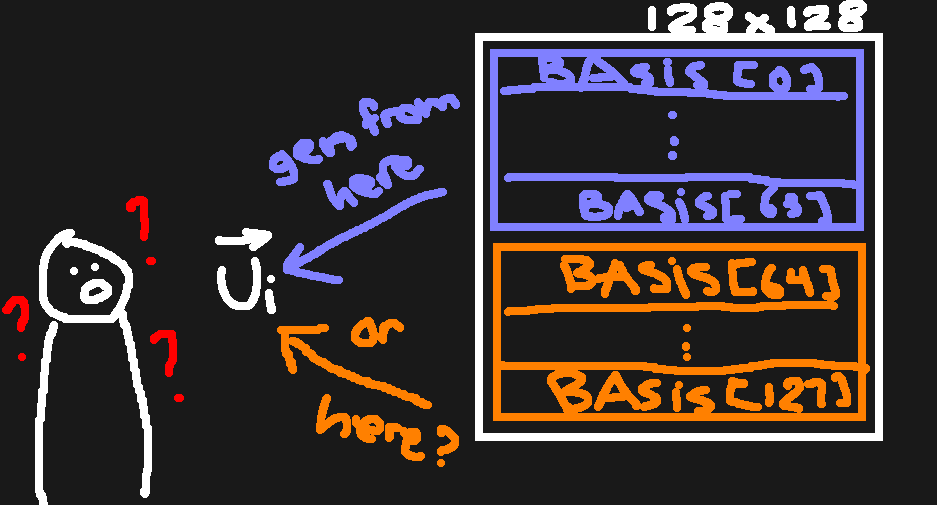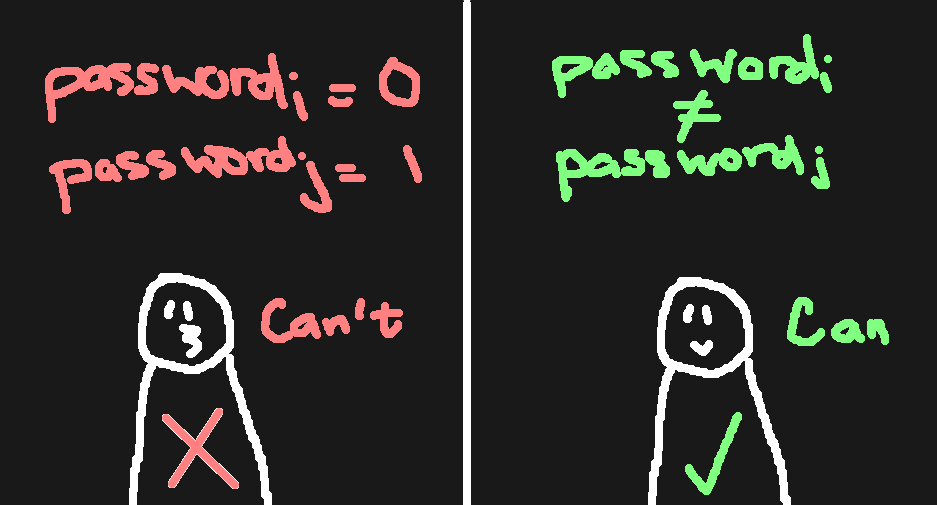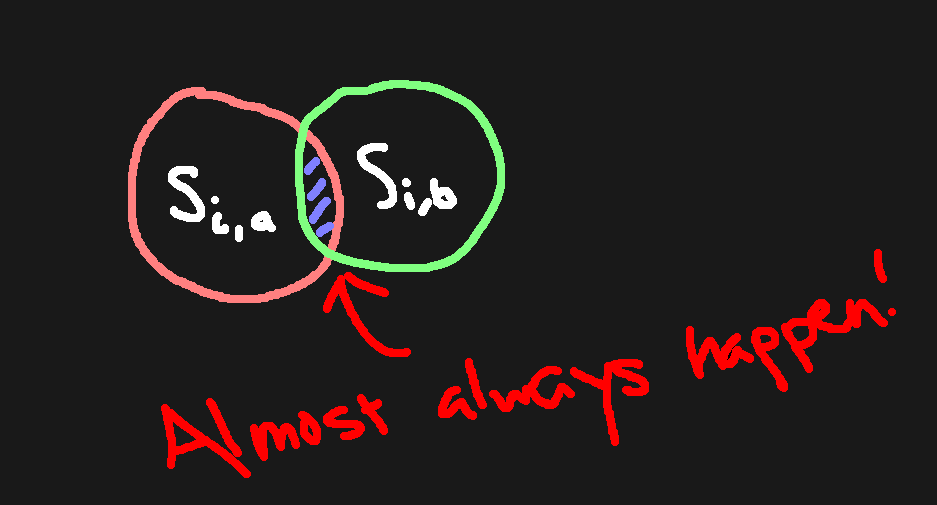Introduction
This is a crazy challenge that drained my team's brains 😢 and we couldn't solve it in time of the CTF 🙁 After 2 days of trying to brainstorm, we have finally be able to crack the code, with a little bit of luck 😗
Since the intended solution will be provided by the author catto after the finals (18/12), which is over ONE MONTH AFTER from when I'm writing these lines (why it gotta take so long catto 😭 😭 😭), I decided to create my own writeup to explain our method of solving this problem 😗
Challenge
Description
The server generates a securely random 64-bit hex string password that is kept secret. We as the clients have to guess the secret password to get the flag.
The server gives us hints about the password through the output of the encrypt(password), which is a function we can call as many times as we can, each time it seemingly produces a different output despite feeding the same input to the function.
This writeup provides a way to obtain the flag with 8 outputs of encrypt(password) in a probability of about .
Code
#!/usr/bin/env python3
from secret import SECRET_BASIS
from secrets import token_hex
import random
import os
import copy
assert len(SECRET_BASIS) == len(SECRET_BASIS[0]) == 128
BASIS = copy.deepcopy(SECRET_BASIS)
def f(M: list[list[int]], C: list[int]) -> list[int]:
v = [0] * len(M[0])
for c, m in zip(C, M):
if c:
v = [x ^ y for x, y in zip(v, m)]
return v
def random_bits(n: int) -> list[int]:
return list(map(int, bin(random.getrandbits(n))[2:].rjust(n, "0")))
def encrypt(message: bytes) -> str:
global BASIS
random.shuffle(BASIS)
M = [b for c in message for b in map(int, "{:08b}".format(c))]
ct = []
for bit in M:
C = random_bits(64)
v = f(BASIS[:64], C) if bit else f(BASIS[64:], C)
ct.extend(v)
ct = "".join(map(str, ct))
return bytes([int(ct[i:i+8], 2) for i in range(0, len(ct), 8)]).hex()
def decrypt(ciphertext: str) -> bytes:
# TODO: implement this pls
pass
def action_prompt() -> int:
print('''============= MENU =============
1. Have a guess
2. Get ciphertext
3. Change password
4. Quit
================================\n''')
try:
option = int(input("Your option> "))
except:
return None
return option
def chall():
try:
password = token_hex(8)
while True:
option = action_prompt()
if option == 1:
user_password = input("Input your password (hex): ")
if user_password == password:
print(f"Is taking the red pill worth it? Here is the truth that you want: {os.environ['FLAG']}.")
else:
print("Guess you can't escape the matrix after all.")
break
elif option == 2:
print(f"Leaky ciphertext: {encrypt(bytes.fromhex(password))}")
elif option == 3:
print("Generating super secure password ...")
password = token_hex(8)
elif option == 4:
print("Maybe the truth is not that important, huh?")
break
else:
print("Invalid option.")
print("\n")
except:
print("An error occured!")
chall()
Analyzing stuffs...
Let's first dissect everything in the source code to see what it does and how to make sense of the data given to us 😗 If you've already known what to expect, you can hop onto the next section to see the discussion of the solution ❤️
encrypt(message) converts message in hex form to its binary form M as a list of 0 and 1s,
def encrypt(message: bytes) -> str:
...
M = [b for c in message for b in map(int, "{:08b}".format(c))]
...
For each bit of M, it generates a random 64-bit value C (also a list of 0 and 1s),
def random_bits(n: int) -> list[int]:
return list(map(int, bin(random.getrandbits(n))[2:].rjust(n, "0")))
def encrypt(message: bytes) -> str:
...
for bit in M:
C = random_bits(64)
...
calls f(C, [:64]) or f(C, BASIS[64:]) depending on the current bit of M, appends the result of the call to the ct variable.
def encrypt(message: bytes) -> str:
global BASIS
...
ct = []
for bit in M:
C = random_bits(64)
ct = []
for bit in M:
C = random_bits(64)
v = f(BASIS[:64], C) if bit else f(BASIS[64:], C)
ct.extend(v)
BASIS is a global variable, a 2-dimensional list with size 128x128 with unknown content whose rows are shuffled in every call to encrypt().
assert len(SECRET_BASIS) == len(SECRET_BASIS[0]) == 128
BASIS = copy.deepcopy(SECRET_BASIS)
...
def encrypt(message: bytes) -> str:
global BASIS
random.shuffle(BASIS)
...
After loop, ct is then converted to its hex form and returned to the user. From this code, it is safe to assume that the value of ct is a list consisting of all 0s and 1s.
def encrypt(message: bytes) -> str:
...
ct = []
for bit in M:
...
ct.extend(v)
ct = "".join(map(str, ct))
return bytes([int(ct[i:i+8], 2) for i in range(0, len(ct), 8)]).hex()
Also, it can be deduced from ct and the type hints and operations of f(), which is just bunch of repeated XORs of values in v andM[i] (M is BASIS[:64] or BASIS[64:]), that BASIS also consists of 128x128 values of 0s and 1s.
def f(M: list[list[int]], C: list[int]) -> list[int]:
v = [0] * len(M[0])
for c, m in zip(C, M):
if c:
v = [x ^ y for x, y in zip(v, m)]
return v
All of these XORs and 2-dimensional arrays and lists of 0s and 1s seem to point everything into viewing those things as addition of matrices and vectors in . And it turns out we can view:
-
BASISas a 128x128 matrix in . -
As for
f(M, C), there are two ways to view this function:You can either view it as an operation that produces a 1xn vector
vby multipling a 1xm vectorCwith an mxn matrixM,or as an operation that generates a linear combination of the rows in
Mwith coefficients onC.I'll choose to see it in the 2nd way because it helps when discussing the solution later 😁
-
encrypt(message)randomizesCand usesf(BASIS[...], C)to produce random linear combinations of the first 64 rows ofBASISor the last 64 rows ofBASISdepending on the current looping bit ofMormessage(0 - first 64, 1 - last 64). All of the resulting vectors are stored inctbefore converted into hex form and returned to the user. -
ctis a list of 64 different 128-dimensional vectors in that is either spanned by the last 64 rows ofBASISor the first 64 rows ofBASIS. Each vector inctcorresponds to a bit inpassword.
Now we know how to view the encrypted password, let's discuss the solution!
How to know the bits of password?
In order to get all the bits of password, we must be able to classify which vector in ct belongs to which vector space. Is generated from BASIS[:64] (so is 0), or BASIS[64:] (so is 1)?

We don't even have BASIS, so if we know a particular vector is formed by a set of 64 rows in BASIS, we can't even tell if that set positions at the top of the matrix or the bottom! The only bet for us is to know which bit is different from which bit by comparing the vector space that spans the corresponding vectors. If we've got the mapping of which bit is different from which bit, we can set one random bit to be 0 and let the mapping does the rest. This gives us the probability of finding the correct answer at (given the mapping, of course 😃)

Notations
Before moving on, I think I should introduce some notations here to help discussing the next part.
-
Bit i of
passwordis . -
is the i-th vector of
ct, generated at a-th time we request to getencrypt(password). -
be the set of rows in
BASISthat generates .Based on the rule of this challenge, we can see that in an -th
encryptoperation:-
BASIS[:64]when , -
BASIS[64:]when ,
Which leads to these properties:
- when .
- when .
-
-
is the probability of some event happening.
-
is the length of set .
Matrix1.0
In Glitch in the matrix 1.0, comparing and is very much doable. To solve this challenge, we have to provide a way to differentiate between the vectors that are either generated from BASIS[:64] or BASIS[64:].
Because password doesn't change every-time we call encrypt and most importantly, BASIS is not changed in the entire runtime of the program, is generated from the same set of 64 vectors as for any , or
This means that we can request 64 encrypts to obtain that is in the same vector space as BASIS[:64] or BASIS[64:]. In order to verify if , or , I created a 128x128 matrix that looks like this:
If the rank of this matrix is , comes from the same span of 64 vectors, so , and we can conclude that . If the rank of this matrix is , the opposite is true and we get .
In script, we fix and let runs from to generate the mapping and recover the password with probability of .
Matrix2.0
Glitch in the matrix 2.0 is the updated version where BASIS is shuffled every-time we request a new encrypt(password). This means that the property that:
is generated from the same set of 64 vectors as where , or ,
is not correct this time around, which is very sad 😭. We also cannot refer to BASIS[:64] and BASIS[64:] as constants anymore.
Probability hint
After a while, a hint came out from the author:

And we still had no idea what the hell she is talking about until the end of the CTF 😦
...
And then, a thought comes to my mind:
While it's true that is not gonna be generated from the same set of 64 vectors as if , some of the vectors in those sets might overlap. Let be the probability of purposefully choosing a set of different 64 vectors to in a list of 128 vectors, then:
proving that this is a very, very, very, very, very unlikely event.
This gives me an insight that the sets and almost always overlap, and from above we've got:

This might be the "probability" thing catto was talking about! Also from this another idea is formed!
Detecting similar bits in password
Let's say we generate encrypt(password) times for .
And somehow, for a certain value of , we obtain the vectors such that:
This means that contains about 127 rows in BASIS except one/some row(s). The remaining row(s) of BASIS would be present in the set of where as always contains the vectors that doesn't have.
And somehow, we can find a set of elements , where .
So, this matrix , which has rows,
must have rank as all of these vectors are generated from the set of , which contains only rows of BASIS.
If we change just one of to a different bit from the rest, the above matrix will most likely have higher rank (often ) than before, since there will be a row in that is a linear combination of the vectors including the one(s) that is/are not in .
Here comes our mechanism to detect similar bits in password. In particular, if we randomize enough times and construct , we might stumble across a situation where has rank and we can use this to say that with high probability.
However, in order for this to work, we need to make sure to choose so that both of these conditions hold:
-
occurs in high probability.
-
Choose that in high probability.
It turns out, if scenario 1. occurs more likely, scenario 2. will occur less likely and vice versa, so we need to balance . Through trials and errors, I've decided to choose and the correct set is found in a probability of about , after brute forcing at most sets.
Recover the remaining bits in password
Remember the matrix from the last section? We can use it to detect the rest of the bits in password. For every -th bit in password that , I decided to construct a new matrix from that is:
Then compares :
-
, we have .
-
, we have .
With this information, we can recover password with a probability of .
Solve code
This piece of code implements what I've just described above, with some small changes:
-
Constructs by brute-forcing through a bigger random list, instead of just . This allows to have even more rows, ensuring us that we get where actually because of , not just some false positives.
-
Uses
multiprocessingto find the list that yields faster.
from Crypto.Util.number import *
from tqdm import tqdm, trange
from pwn import remote, process
from sage.all import *
from multiprocessing import Process, Queue
import random, time
host = '34.132.73.130'
port = int(8003)
B = 64
N = 128
K = 8
targetRank = N-1
def convertToMatrix(input: bytes):
bits = ''
for byte in input:
bits += f'{byte:08b}'
bits = list(map(int, bits))
bits = [bits[i:i+128] for i in range(0, len(bits), 128)]
return Matrix(GF(2), bits)
class Solver:
# -------------------------------------- CONNECT --------------------------------------
def __init__(self) -> None:
self.io = remote(host, port)
def __del__(self):
self.io.close()
def request(self, data):
if isinstance(data, str):
data = data.encode()
elif not isinstance(data, bytes):
data = str(data).encode()
self.io.send_raw(data + b'\n')
def recvline(self):
return self.io.recvline().strip().decode()
# -------------------------------------- REQUEST --------------------------------------
def get(self, option):
self.io.recvuntil(b'option> ')
self.request(option)
def encrypt(self):
self.get(2)
return convertToMatrix(bytes.fromhex(self.recvline().split(': ')[-1]))
def submit(self, key):
self.get(1)
self.request(key)
def changePassword(self):
self.get(3)
# -------------------------------------- MAIN --------------------------------------
def execOneCore(self, U, Ntries, delta, retQueue, progBar):
choices = list(range(1, B))
for _ in range(Ntries):
random.shuffle(choices)
combination = choices[:N//K + int(N%K != 0) + delta]
P = block_matrix(
[[U[i]] for i in combination]
)
if P.rank() <= targetRank:
retQueue.put([
P.rank(), combination
])
break
if not retQueue.empty():
break
progBar.update()
def findBestComb(self, U, ncores=4, Ntries=100000, delta=2):
# Progress bars
progBars = []
for i in range(ncores):
progBar = tqdm(desc=f'#{i}', total=Ntries)
progBars.append(progBar)
# Hold return values of all cores
retQueue = Queue()
# Create new processes
futures = []
for _ in range(ncores):
futures.append(Process(
target=self.execOneCore,
args=(
U, Ntries, delta,
retQueue,
progBars[_],
)))
# Start all processes
for future in futures:
future.start()
# Wait for all process to finish :)
for future in futures:
future.join()
# Close all progress bars
for progBar in progBars:
progBar.close()
# Get answer!
if not retQueue.empty():
rank, comb = retQueue.get()
return rank, comb
return None, None
def main(self):
M = []
for i in range(K):
M.append(self.encrypt())
U = []
for i in range(B):
u = []
for j in range(K):
u.append([M[j][i, :]])
U.append(block_matrix(u))
print(f"[i] Find combination of vectors that forms a matrix with rank <= {targetRank}...")
rank, comb = self.findBestComb(U, Ntries=100000, delta=2)
if comb == None:
return False
print(f"[i] Best rank: {rank}")
print(f"[i] Best combination: {comb}")
# print(f"[i] Debug matrix:\n{block_matrix([[U[i]] for i in comb], subdivide=False)}")
# Deduce the password bits...
passwordbits = ''
for j in range(B):
if j in comb:
passwordbits += '0'
continue
P = block_matrix(
[[U[i]] for i in comb + [j]]
)
if P.rank() > rank:
passwordbits += '1'
else:
passwordbits += '0'
# Convert it to hex and send to server :)
password = bytes([int(passwordbits[i:i+8], 2) for i in range(0, len(passwordbits), 8)]).hex()
self.submit(password)
print('[i] Password is (maybe):', password)
print('[i] Password bits are (maybe):', passwordbits)
# Get answer from server, which is estimated to be successful at around 1/20...
answer = self.recvline()
print('server>', answer)
if 'Here is the truth that you want' in answer:
return True
return False
cnt = 0
while True:
cnt += 1
solver = Solver()
if solver.main():
break
print(f"[i] Solver took {cnt} times.")